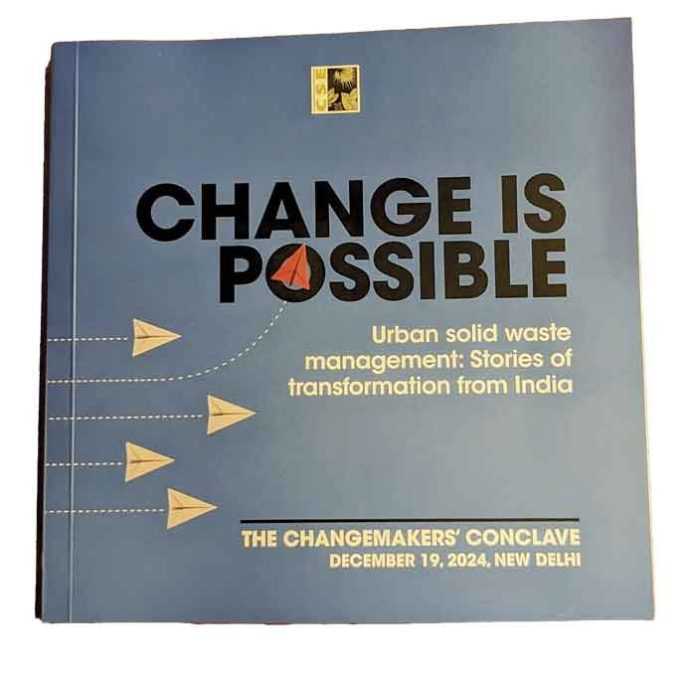
At the Changemakers Conclave in New Delhi on 19 December 2024, Sunita Narain, the director general of the Centre for Science and Environment, said, “Transformation is evident as India wakes up to its solid waste challenge.” The day-long event was a celebration that brought together more than a hundred waste management changemakers from municipalities, urban local bodies, and cities across the country.
The participants were celebrated as changemakers and a booklet titled Change Is Possible was released. It profiles the changemakers and describes the waste management initiatives they have championed in their respective municipalities, cities, or spheres of work.
“India is waking up to meet the challenge of managing its solid waste, and that too, proactively. And the biggest evidence and demonstration of this awakening and transformation is visible in many of our cities. We have gathered here today to acknowledge and celebrate this transformation,” Narain said, adding, “Landfills are always where the rich do not live, but India’s poor have declared, ‘Not in my backyard!’” She said that while the policymakers have listened, “Policy has to keep evolving, dynamically adapting to change. Action stops when policy stops getting reformed, and action thrives when policy adapts and changes.”
Besides Narain, participants at the conclave were addressed by Roopa Mishra, joint secretary and national mission director, Swachh Bharat Mission, Union Ministry of Housing and Urban Affairs; Angela Lusigi, resident representative, UNDP India; Dr Balakrishna Pisupati, country head, UNEP India; and, experts and senior municipal officials from across the country.
Mishra said, “Swachh Bharat Mission 2.0 is not merely a government initiative. It has maintained its momentum for over a decade, driven by seamless collaboration between cities, states, other stakeholders, and partners – showcasing a unified effort towards a cleaner and healthier India.” SBM 2.0 has set a target of making India garbage–free by 2026 with an emphasis on solid waste management and hygienic conditions. Involving over 4,900 cities over the past 10 years, the government has made a financial commitment of Rs 1.4 lakh crore (approximately 16 billion Euros) toward maintaining the pace of what she described as the world’s largest behavioral program. She added that the ministry has undertaken to improve the data on the mission’s programs.
The Changemakers event was a celebration of not only that change is possible but that it is happening. It has become clear that local bodies and organizations around the country have seized on the government initiative and advocacy to make it a reality. They have created structures and tools for training, and managing waste by sorting, setting up infrastructure, and empowering workers for turning waste into revenue. Affordability and inclusivity have been the watchwords on the ground.
As Atin Biswas, CSE’s solid waste management and circular economy program director, noted, “SBM 2.0 has paved the way for India’s urban managers – local governments, civil society, industry partners, and others to equip themselves with the capacity to understand and implement the nuances of the circular economy in managing solid waste in an environmentally sustainable and financially viable manner. What CSE has done is to help build that capacity through its specially designed and curated training programs.”
The programs range from implementing waste segregation at source, door-to-door collection of segregated waste, and running communication, awareness-building, and behavior-change campaigns. They have helped to effect investment in waste management infrastructure such as material recovery facilities and in implementing steps to ensure the financial viability of waste management processes.
For people like myself who are generally skeptical of government programs, the event was a revelation. One could see that while the flexible packaging industry keeps making excuses for its slow pace of change, saying the problem is elsewhere, with the government or with waste collection, the rest of society is walking the walk. Since plastic packaging is merely a subset of any circular economy and its solid waste management, municipalities with the help of civil society are actively taking up the complex challenges of waste collection, sorting, and recycling.
Just as consumers are ahead of the industry in their demands for less packaging and more recyclable packaging, civil society, municipalities, and government advocacy are also far ahead of the industry in solid and plastic waste management. It may be better for the plastic packaging industry to get on board the moving train, rather than avoiding their responsibility and role in facing this complex challenge.








